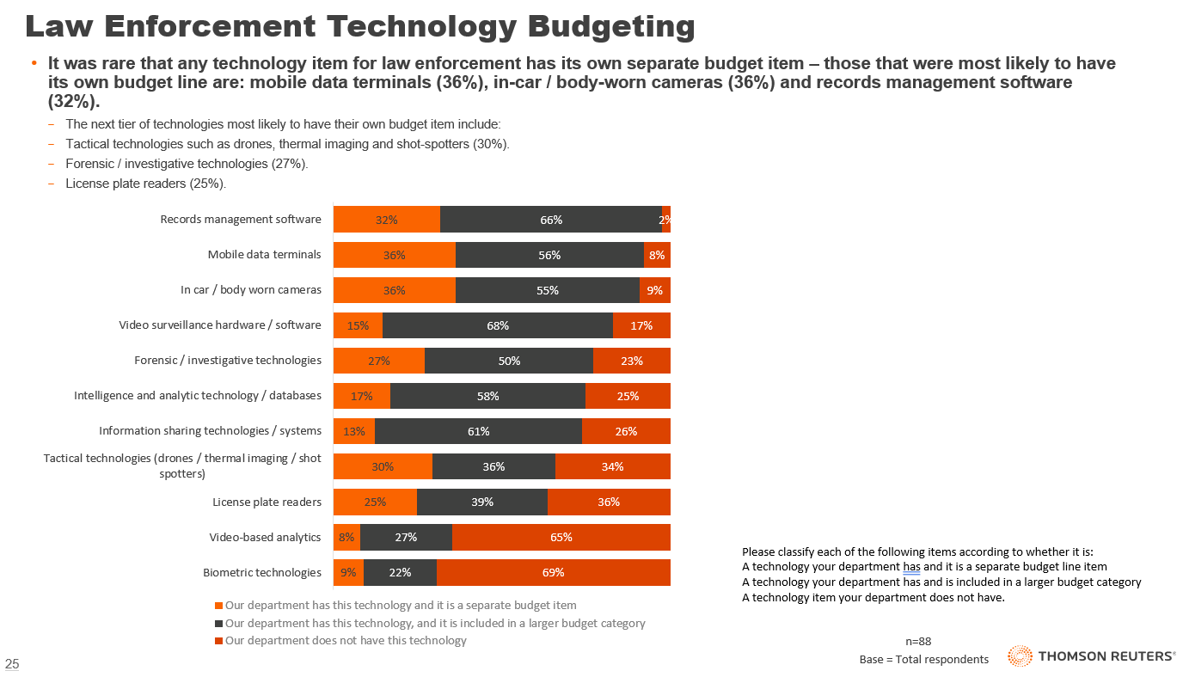Faced with increasing crime, staffing issues, and challenges to their approaches to community policing, how can law enforcement agencies better use more advanced technology to solve these problems?
With crime rates increasing in many areas, it is important for law enforcement organizations to look for opportunities to protect the community at large. The lingering question, of course, is how to handle the higher crime rate in the context of a finite budget and other limiting factors.
And while the answer does not lie simply in the need for more law enforcement, it does point to law enforcement’s need to be properly equipped to resolve issues more quickly and efficiently. Indeed, law enforcement needs proper training, updated equipment, and proper evidence storage to allow it to function properly in today’s climate.
Law enforcement is tasked with handling everything from traffic stops to domestic disturbances to the unthinkable with plenty of stops in between. That is a large task to take on, even when fully staffed. In a new report from Thomson Reuters, Data and technology: How law enforcement agencies see the future, 48% of law enforcement respondents surveyed said that staffing concerns were their top issue of concern, and more than two-thirds (68%) indicated that staffing concerns were in their top three areas of concern. Further, about one-third (33%) of respondents also said that issues with keeping technology up to date was one of their top three areas of concern as well.
The survey also indicated that departments dealing with increasing crime rates and those in mid-size jurisdictions place a higher priority on assessing and investing in technologies to improve policing effectiveness. It seems clear that even members of law enforcement know that more officers are needed. The caveat is, however, if we can’t have more officers, the ones we have should be better equipped to serve the needs of their community.
The study goes further to explain that those technology tools being purchased by law enforcement, including in-car/body-worn cameras (58%); license plate readers (39%); drones/thermal imaging/shot spotters (34%); forensic/investigative technologies (33%); and video surveillance hardware/software (32%). Each of these pieces of technology will enable law enforcement to do their jobs more effectively.

Technology is a large step in the direction of providing a safer community within the confines of a limited budget and expanding population. The proper use of technology provides consistency, objectivity, and protection for the agency as well as the citizen.
Benefits of technology
For example, bodycams are one way that technology can increase effectiveness. A 2017 National Institute for Justice study found that police are more proactive in crime prevention activities when wearing cameras. Body-worn cameras also were found to provide compelling evidence to build legal cases. Their use largely affirmed and validated positive officer behavior and protected police from false or frivolous complaints, while reducing inappropriate use of force by officers. (Indeed, bodycams may have saved the Las Vegas Metro Police Department millions of dollars through a reduction of complaints and ultimate financial settlements against officers.)
Investment in this basic technology would likely have an overall positive impact, which is desired by both officers and the community. And as said, it would also promote objectivity and provide critical evidence in legal proceedings.
Upgrades in evidence and digital forensics technology can also assist with the resolution of more advanced and technical crimes. Improved technology and digital forensics allow officers to investigate crimes and locate criminals more efficiently and more quickly. In cases in which the crimes are digital — such as online harassment or stalking — the use of digital forensics expedites the investigative process. Digital forensics technology allows officers to collect data that can otherwise be quickly destroyed, making the investigation more difficult.
In addition to those upgrades, new technologies like drones are designed to keep officers safer and disseminate information to the public. For instance, New York City is testing the use drones to notify neighborhoods that may be experiencing weather events. This type of technology can also be used to assess hostage or active shooter situations without putting officers physically at risk.
Further, drones can get to areas more quickly than actual officers, which allow the area to be cleared and attention to be focused on the correct areas. The usefulness and benefits of drones are clear in Chula Vista, Calif., where officers are able to quickly clear calls and send the appropriate resources. Moreover, drones don’t have the same physical constraints as do individual officers.
In addition to the work law enforcement officers do to protect the community in real-time, they must also participate in the judicial process, which means officers need to maintain appropriate records. And this means there needs to be adequate digital evidence repositories that can store not only digital evidence but also video footage and even basic notes. These storage systems are more important to the future of policing as the efficient solving of crimes becomes more technologically advanced.
The future of police and law enforcement lies in the ability to adapt and adjust to new technologies with the continued support of the community. This requires a mutual understanding that technology promotes objectivity and efficiency that allows the police to do a better job. It also requires a commitment from the government to balance investments in officers and technology.
While the newer technology makes the job better, there needs to be adequate numbers of law enforcement personnel to complete this difficult job.







